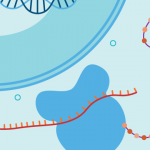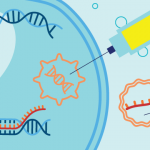
Part 5: Trick and teach – How vaccines work and why they are important
Vaccines are not a treatment for disease. They are a preventative measure against developing severe disease or dying from an infection – they help healthy people stay healthy.
Your immune system works by constantly looking for something foreign in your body. One way in which it does this is by looking at the shape of surface structures, such as proteins. If the structures it encounters are not your own, the immune system sounds the alarm and responds. Structures which trigger an immune response are called antigens.
By making sure that the antigen resembles one or more parts of the real virus, the immune system is tricked into thinking that its being infected. Our bodies respond with a short-term immune response, which causes the symptoms some people may experience after vaccination, such as tiredness, fever, or muscle pains. The immune system does something else as well, it learns. It takes a set of immune cells and antibodies and trains them to fight that particular virus. This is what we refer to as immune memory, or just “immunity”.
If the real virus ever makes its way into your body, your immune system will know how to assemble the antibodies to destroy the intruder quickly. These memory cells respond faster and more effectively to prevent infection, allowing your body to eliminate the virus sooner and prevent the development of severe disease.












